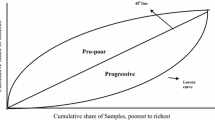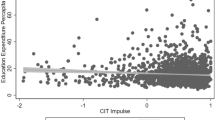Abstract
This study examines the impact of Central transfers on elementary education expenditure. It also estimates additional transfers required by the States to enable them to provide minimum and comparable level of elementary educational services. Using the data for 28 Indian States from 2009–10 to 2020–21, and the static panel data methodology, it initially estimates the Elementary Education Expenditure Function. Based on the estimated values from the expenditure model and two benchmarks: all States’ average and top three States’ average per student expenditure on elementary education, it computes the expenditure gap in each State and transfers needs. Findings of the study reveal that the existing transfers mechanism has failed to compensate the lagging States. While grants have a positive and significant impact on expenditure, there is no evidence of a flypaper effect, which indicates that specific purpose transfers would be more effective. Bihar, West Bengal, Uttar Pradesh, and Madhya Pradesh have a large expenditure gap and hence require maximum transfers. Given the target of 6% of GDP to the education sector, the additional transfers estimates are quite reasonable. The findings of the study will aid policymakers and researchers to develop appropriate strategies and design a transfer mechanism that would ensure equity in elementary education.
Similar content being viewed by others
Data availability
The methodology includes a section of data used in the study and its sources. The basic data has been compiled by the authors from various sources and can be madeavailable on request.
Notes
As far as general purpose transfers are concerned, States have autonomy over how much they want to allocate for Elementary Education Sector.
Sarva Shiksha Abhiyaan is a centrally sponsored scheme introduced to universalised elementary education in India. It is now a component of the Samagrah Shiksha Abhiyaan.
The Finance Commission is appointed once in every five years, to determines the resource sharing arrangements between the Centre and the State governments.
Data on elementary schooling expenditure, outcomes, infrastructure and GSDP is shown in the Appendix (Table A.1).
KVs are central schools designed to cater to the children of Central government employees.
If benchmark is changed to top 5 States’ average, the total transfers required is estimated at ₹1,53,889 crore (2% of GDP) and ₹3,56,829.92 crore (2.6% of GDP) for 2009–10 and 2020–21 respectively.
Feasibility of resource allocation depends on revenue side equalisation, which is beyond the scope of this paper.
The Kothari Commission, 1964 recommended that India should allocate 6% of GDP to the education sector. Typically, half of the total education expenditure is allocated for elementary education. Therefore, a targeted allocation of 3% of GDP to the elementary education sector is justifiable.
References
Akanbi, A., & Schoeman, N. (2011). The determinants of public expenditure and expenditure on education in particular in a selection of African countries. South African Journal of Economic and Management Sciences, 13(1), 50–61. https://doi.org/10.4102/sajems.v13i1.196
Bischoff, I., & Prasetyia, F. (2019). Determinants of local public expenditures on education: Empirical evidence on Indonesian municipalities between 2005 and 2012. International Journal of Education Economics and Development, 10(2), 115. https://doi.org/10.1504/ijeed.2019.098683
Bose, S., P. Ghosh, and A. Sardana. (2020a). RTE and The Resource Requirements: The Way Forward, National Institute of Public Finance and Policy and Eklavya Foundation.
Bose, S., Ghosh, P., & Sardana, A. (2020b). Financing the right to education: Role of fifteenth finance commission. Economic and Political Weekly, 55(37), 44–52.
Busemeyer, M. R. (2007). Determinants of public education spending in 21 OECD democracies, 1980–2001. Journal of European Public Policy, 14(4), 582–610. https://doi.org/10.1080/13501760701314417
Chakrabarti, A. and R. Joglekar. (2006). Determinants of Expenditure on Education: An Empirical Analysis Using State Level Data, Economic and Political Weekly, 1465–1472.
Chatterji, M., Mohan, S., & Dastidar, S. G. (2015). Determinants of public education expenditure: Evidence from Indian states. International Journal of Education Economics and Development, 6(1), 1. https://doi.org/10.1504/ijeed.2015.068355
Comptroller and Auditor General of India. (2022). State Accounts Report [Database], Government of India, https://cag.gov.in/en/state-accounts-report.
Cruz, T., & Silva, T. (2020). minimum spending in education and the flypaper effect. Economics of Education Review, 77, 102012. https://doi.org/10.1016/j.econedurev.2020.102012
Dragomirescu-Gaina, C. (2015). An empirical inquiry into the determinants of public education spending in Europe. IZA Journal of European Labor Studies. https://doi.org/10.1186/s40174-015-0049-7
EPWFR. (2022). Economic and Political Weekly Research Foundation: India Time Series [Database], Sameeksha Trust, https://epwrfits.in
Government of India. (1990). Report of the Ninth Finance Commission, Finance Commission of India.
Government of India. (2001). Census of India, Office of the Registrar General and Census Commissioner, Ministry of Home Affairs.
Government of India. (2004). Report of the Twelfth Finance Commission, Finance Commission of India.
Government of India. (2009). Report of the Thirteenth Finance Commission, Finance Commission of India.
Government of India. (2011). Census of India, Office of the Registrar General and Census Commissioner, Ministry of Home Affairs.
Government of India. (2014). Report of the Fourteenth Finance Commission, Finance Commission of India.
Government of Indi. (2020a). Report of the Fifteenth Finance Commission. Finance Commission of India.
Government of India. (2020b). National Education Policy 2020b, Ministry of Education.
Government of India. (2022). Population Projection in 6–23 years of age group [Datafile], Ministry of Education, https://www.education.gov.in/en/statistics-new
Jabbar, N., & Selvaratnam, D. P. (2017). Analysis of the determinants of education expenditures in Malaysia. Journal of International Business, Economics and Entrepreneurship, 2(1), 1. https://doi.org/10.24191/jibe.v2i1.14455
Levin, H. M. (1985). Are block grants the answer to the federal role in education? Economics of Education Review, 4(3), 261–269. https://doi.org/10.1016/0272-7757(85)90011-1
Litschig, S. (2008). Intergovernmental transfers and elementary education: quasi-experimental evidence from Brazil. SSRN Electronic Journal. https://doi.org/10.2139/ssrn.1374854
National Statistical Office. (2022). Statistical Publications, Ministry of Statistics and Programme Implementation.
Nose, M. (2017). Estimation of drivers of public education expenditure: Baumol’s effect revisited. International Tax and Public Finance, 24(3), 512–535. https://doi.org/10.1007/s10797-016-9410-7
Prachita, J. (2012). Health Expenditure of State Governments: Determinants, Needs and Outcome Efficiency, Doctoral Thesis. https://shodhganga.inflibnet.ac.in/handle/10603/204376
Ramachandran, V. K., V. Rawal and M. Swaminathan. (1997). Investment Gaps in Primary Education: A State Wise Study, Economic and Political Weekly, 39–45. https://www.jstor.org/stable/4404965
Rangarajan, C. and D. K. Srivastava. (2004). Fiscal Transfers in Australia: Review and Relevance to India, Economic and Political Weekly, 3709–3722. https://www.jstor.org/stable/4415416
Roy, A., B. Kamaiah and M. G. Rao.(2000). Educational Expenditure of Large States: A Normative View, Economic and Political Weekly, 1465–1469.
Saastamoinen, A. and M. Kortelainen. (2018). When Does Money Stick in Education? Evidence from a Kinked Grant Rule, VATT Institute for Economic Research Working Paper No. 102.
Saraf, R. and D. K. Srivastava. (2009). Determining General and Specific Purpose Transfers: An Integrated Approach, Madras School of Economics. https://www.mse.ac.in/wp-content/uploads/2016/09/working-paper-40.pdf
Searle, B. (2002). Federal fiscal relations in Australia-2001. International Centre for economic research.
Thomson, N. J. (1985). Federal Equalisation Funding of Schools in Australia, Journal of Education Finance, 460–473.
Tilak, J. B., and Kar, D. K. (1994). Requirements of Resources for Education in India: Implications for the Tenth Finance Commission. NIEPA, New Delhi.
Unified District Information System on Education. (2022). Elementary Dashboard [Database], New Delhi: National Institute of Educational Planning and Administration. https://dashboard.udiseplus.gov.in/#/reportDashboard/sReport
Verbina, I., & Chowdhury, A. (2004). What determines public education expenditures in Russia?1. The Economics of Transition, 12(3), 489–508. https://doi.org/10.1111/j.0967-0750.2004.00190.x
Funding
University Grants Commission, 83/NET-JULY2016, Jyotsna Rosario.
Author information
Authors and Affiliations
Corresponding author
Ethics declarations
Conflict of interest
On behalf of all the authors, the corresponding author states that there is no conflict of interest.
Additional information
Publisher's Note
Springer Nature remains neutral with regard to jurisdictional claims in published maps and institutional affiliations.
Appendix
Appendix
See Table
9.
Rights and permissions
Springer Nature or its licensor (e.g. a society or other partner) holds exclusive rights to this article under a publishing agreement with the author(s) or other rightsholder(s); author self-archiving of the accepted manuscript version of this article is solely governed by the terms of such publishing agreement and applicable law.
About this article
Cite this article
Rosario, J., Shanmugam, K.R. Impact of transfers on elementary education expenditure and measuring equalisation transfers to Indian States. Ind. Econ. Rev. 58, 141–168 (2023). https://doi.org/10.1007/s41775-023-00190-z
Accepted:
Published:
Issue Date:
DOI: https://doi.org/10.1007/s41775-023-00190-z
Keywords
- Education finance
- Equalisation transfers
- Elementary education
- Public expenditure
- Indian States
- Panel data




